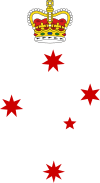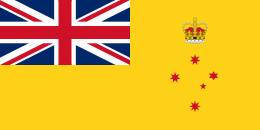Arthur Somers-Cocks, 6th Baron Somers
| The Right Honourable The Lord Somers KCMG DSO MC | |
|---|---|
| 16th Governor of Victoria | |
|
In office 28 June 1926 – 23 June 1931 | |
| Monarch | George V |
| Premier |
John Allan Edmond Hogan William McPherson |
| Preceded by | Lord Stradbroke |
| Succeeded by | Lord Huntingfield |
| Personal details | |
| Born |
20 March 1887 Freshwater, Isle of Wight, England |
| Died |
14 July 1944 (aged 57) Ledbury, Herefordshire, England |
| Spouse(s) |
Daisy Meeking (m. 1921) |
| Alma mater | New College, Oxford |
Arthur Herbert Tennyson Somers-Cocks, 6th Baron Somers KCMG, DSO, MC (20 March 1887 – 14 July 1944) was a British Army officer who served as the 16th Governor of Victoria, in office from 1926 to 1931. He had a long involvement with the Scout Movement, and was Chief Scout of the British Empire from 1942 until his death, in succession to Robert Baden-Powell.
Early life
Somers was born in Freshwater, Isle of Wight, the eldest son of Herbert Haldane Somers-Cocks and the former Blanche Clogstoun. His godfather was Alfred, Lord Tennyson. Somers' father died when he was seven years old. He succeeded a distant relative as Baron Somers at the age of twelve. He attended Charterhouse School before going on to New College, Oxford.[1] He was an able cricketer, and played 17 first-class games. In 1904, whilst a schoolboy at Charterhouse, he made 115 against Westminster,[2] and two years later he made his first-class debut for Marylebone Cricket Club (MCC) against Worcestershire, scoring 0 and 13.[3] He rarely had enough time to play cricket, but in the 1920s he made a further 16 first-class appearances for Worcestershire, his highest score being 52 against Essex in May 1925.[4] In later life he became both a vice-president of Worcestershire County Cricket Club and, in 1936, President of the MCC.[2]
Military career
In 1906, Somers joined the 1st Regiment of Life Guards of the British Army, later taking leave to farm in Canada before rejoining his regiment in 1914 at the start of World War I. He commanded the 6th Battalion of the new Tank Corps in 1918. He was twice wounded, mentioned in dispatches, awarded the Military Cross, the Distinguished Service Order, and appointed to the Légion d'honneur.[1]
Governor of Victoria
Somers was appointed Governor of Victoria in 1926, in succession to Lord Stradbroke. Aged 39, he was (and remains) one of the youngest holders of the office. He "had charm and natural gaiety which won him popularity ... warm and generous, he had a genuine interest in people, as well as a high sense of duty and leadership ... a shrewd and successful governor".[1] A Freemason, he was initiated in the House Brigade Lodge 18 years before he arrived in Victoria, and served as the Grand Master of the United Grand Lodge of Victoria between 1927 and 1932.[5] Following the expiry of Lord Stonehaven's term as Governor-General in October 1930, Somers – as the longest serving state governor – was called upon to act as Administrator of the Commonwealth until Sir Isaac Isaacs took office in January 1931.[6]
Scout Movement
In 1929, at his own expense, Somers brought together teenage boys from different backgrounds in Australia to what was named Lord Somers Camp which continues to this day. Back in England, he was appointed Chief Commissioner of the Boy Scouts in 1932, was deputy Chief Scout from 1935 to 1941, and was designated by Lord Baden-Powell, the founder of the Scout Movement, who had been Chief Scout of the World, as his successor as Chief Scout. He was appointed as Chief Scout of the British Empire in March 1941, on the death of Baden-Powell.[1][7] He served until his death in 1944. He was succeeded by Lord Rowallan.
Family
Somers married Daisy Finola Meeking in 1921 and had issue, an only daughter:
- Hon.Elizabeth Violet Virginia Somers Cocks (1922–1986), who married Major Benjamin Alexander Frederick Hervey-Bathurst (1920–1997), 2nd son of Sir Frederick Edward William Hervey-Bathurst, 5th Bt.
Notes
- 1 2 3 4 Australian Dictionary of Biography article on Lord Somers
- 1 2 Obituaries, 1944. Wisden Cricketers' Almanack, 1945.
- ↑ "Marylebone Cricket Club v Worcestershire in 1906". CricketArchive. Retrieved 15 March 2009.
- ↑ "Essex v Worcestershire in 1925". CricketArchive. Retrieved 15 March 2009.
- ↑ Thorton, Peter T; Lord Somers, Grand Master (1989). "12". A Century of Union. United Grand Lodge of Victoria. pp. 115–120. ISBN 0 7316 5791 8.
- ↑ Christopher Cunneen, Kings' Men: Australia's Governors-General from Hopetoun to Isaacs, 1983, George Allen & Unwin, p.172.
- ↑ "Meet the Chiefs" (PDF). The Scout Information Centre. October 2004. Archived (PDF) from the original on 31 October 2007. Retrieved 8 December 2007.
References
- Arthur Somers-Cocks, 6th Baron Somers at CricketArchive (subscription required)
- Arthur Somers-Cocks, 6th Baron Somers at ESPNcricinfo
| Honorary titles | ||
|---|---|---|
| Preceded by Sir John Cottrell, Bt |
Lord Lieutenant of Herefordshire 1933–1944 |
Succeeded by Sir Richard Cottrell, Bt |
| Political offices | ||
| New title New government |
Lord-in-waiting 1924–1926 |
Succeeded by The Earl of Airlie |
| Government offices | ||
| Preceded by The Earl of Stradbroke |
Governor of Victoria 1926–1931 |
Succeeded by The Lord Huntingfield |
| Peerage of the United Kingdom | ||
| Preceded by Philip Cocks |
Baron Somers 1899–1944 |
Succeeded by Arthur Somers-Cocks |
| The Boy Scouts Association | ||
| Preceded by Robert Baden-Powell |
Chief Scout of the British Empire 1941–1944 |
Succeeded by The Lord Rowallan |
| Masonic offices | ||
| Preceded by William Bice |
Grand Master of the United Grand Lodge of Victoria 1927-1932 |
Succeeded by William Kerr |

